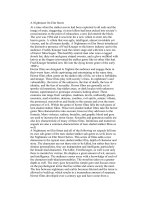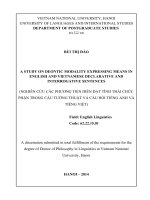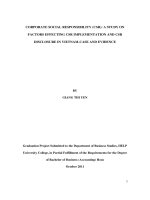GETTING A HANDLE ON SUBJECTIVE TESTING
Bạn đang xem bản rút gọn của tài liệu. Xem và tải ngay bản đầy đủ của tài liệu tại đây (114.7 KB, 14 trang )
Getting a Handle on Subjective Testing
33
Secret 3
G
ETTING A
H
ANDLE ON
S
UBJECTIVE
T
ESTING
G
ene, Nita, and Tomoyuki sat in a far corner of the
school library and faced their day of reckoning.
Determined to do well on their Advanced Placement
(AP) English test, the three classmates agreed to prac-
tice their essay-writing skills together. Nita downloaded
sample AP English essay questions from the Internet.
Then they chose a question asking for a comparison of
two Robert Frost poems, and they each wrote a rough-
draft essay. Today was the peer-review stage in which
each study group member would read another’s essay
and critique it.
“Are we still going to be friends after this?” Tomoyuki
asked half-seriously. Gene critiqued Tomoyuki’s essay
first. Tomoyuki became a little defensive when Gene
began with how difficult it was for him to read Tomoyuki’s
handwriting. Gene also thought that Tomoyuki’s essay
focused on one poem, with little mention of the second.
Nita found that Gene’s essay seemed to make the same
point several times and had no closing sentence.
Tomoyuki thought Nita had a terrific thesis statement but
lacked logical connections leading from one point to
another.
“Combined, we’re perfect,” Gene joked.
Gene, Nita, and Tomoyuki formed different opinions of what they
read, so how can subjectivity possibly determine a fair grade? As you
can tell from their experience, subjective tests are generally more
complex than objective ones. When taking subjective exams, you have
to do more than just select the correct answer from among several
choices: You have to create a concise, often original, answer in your
own words. This chapter will help you understand the different types
of subjective testing, what they test, and how to study for them.
THE PURPOSE OF SUBJECTIVE
TESTING
In the previous chapter, objective testing and the types of questions
you can expect to find on that type of test were discussed. The topic
of this chapter is subjective testing. This type of test often causes
more stress for students because the distinction between a right and
wrong answer is not always as clear as in objective testing. Also, in the
subjective test, students may be asked to expand their thoughts
beyond the facts that were taught in class, and they may be expected
to form their own opinions and then provide the statistics or facts to
support them. Subjective tests are almost always graded by people,
not machines, which means that human opinion enters into deter-
mining how right or wrong a response is.
So, what is subjective testing? Subjective exams may call for
responses ranging from a paragraph to several pages in length,
depending on what type of question is involved. Subjective testing
evaluates not only how well a student has memorized and can recall
facts and theories but often also requires that the student take the
information that was learned in the classroom and expand on it. By
using this form of test, the educator can assess not only how well stu-
dents have learned facts but also how well they have learned theory.
The questions on a subjective test usually encourage the student to uti-
lize a variety of skills, from critical thinking to creativity, from proper
spelling to proper sentence structure. The student will often need to take
pieces of information that were learned and meld them into a coherent
and convincing answer. Because the student is asked to formulate an
answer this way, the subjective test can be a bit more difficult to study for.
The three students in the opening vignette provide a perfect exam-
ple of the scoring process behind subjective tests. Although all three
34
10 SECRETS TO ACING ANY HIGH SCHOOL TEST
of the students thought that they had done suitable work, each was
able to point out the areas where the others were lacking or where
they could improve. Of course, all of the feedback provided was opin-
ion based on a set of criteria, but many of the opinions are likely to be
shared by the person scoring the AP test.
DIFFERENT TYPES OF SUBJECTIVE TESTS
There are several different types of subjective test questions. As you
advance in your high school career, you are likely to see more and
more of these types of tests.
Essay
There is nothing that can cause a collective groan in the classroom
more effectively than a teacher informing students that the next test
is going to include an essay question. The mere possibility of essay
questions can send students into a panic.
Fortunately, because you are going to be well prepared and confi-
dent after using this book, you will no longer be one of those students.
Essay questions may never be one of your favorite testing methods,
but as you uncover the secrets to mastering them, you will become
more comfortable with them.
Tips for Mastering Essay Questions
Consider the following sample essay question: Personification is the
technique wherein a nonhuman character is given human thoughts,
feelings, and dialogue. Illustrate how this technique is used in your
favorite novel or short story.
1. Read the directions and all questions carefully.
As with any type of test, it is imperative that all directions are read
carefully and completely. Pay special attention to the question that
you are being asked to answer. Identify key words and statements.
These are clues to the expected answer. If you are permitted,
underline the key words so that you can remain focused on exactly
what the question is asking. Try to rephrase the question in the
topic sentence of your answer.
Getting a Handle on Subjective Testing
35
The key words in the sample essay question are underlined
below:
Personification
is the technique wherein a nonhuman character
is given human thoughts
, feelings, and dialogue. Illustrate how this
technique
is used in your favorite novel or short story.
2. Use your time wisely.
As with objective test questions, it is very important that you use
your time wisely. After you have read all of the test questions, pri-
oritize which you are going to answer first, then estimate how
much time you are going to allot for each question. Try to answer
the least taxing questions first, moving on to those that will require
more in-depth thought. By the time you reach the questions that
require more thought, you should be in a groove, and your
thoughts will be flowing more freely.
3. Create a short outline.
Before beginning a lengthy, disorganized exposition of your
thoughts, use the key words and phrases that you identified earlier
to outline your answer. Write this brief outline in the margin of
your page or on scrap paper. This outline will help you stick to the
point, keep your answer concise, and save you a lot of erasing when
you realize that you have gone off track. A well-organized answer
will be easy for the instructor to read, and, therefore, easy for the
instructor to score. Here’s a sample outline:
I. Introduce personification and Kipling’s “Rikki-Tikki-Tavi”
II. Rikki-Tikki-Tavi as a humanized mongoose
III. Personification and the archetype of good and evil
IV. Conclusion
4. Be concise.
For most essay questions, instructors are looking for particular
answers or groups of answers. While they are judging if you
answered correctly and effectively, they will be looking for certain
facts when reviewing the answers. Be sure that you answer only the
question that is asked. Be direct, address all of the keywords and
phrases, and do not allow your answer to be too lengthy.
This passage is too wordy: The technique of personification is a
literary device used in many novels and short stories by many writ-
ers. In the short story “Rikki-Tikki-Tavi” by the author Rudyard
36
10 SECRETS TO ACING ANY HIGH SCHOOL TEST
Kipling, nonhuman animals are personified, and they are also given
the ability to be able to speak to each other in English. The fact
that they are able to speak to each other like human beings makes
them seem more real.
This passage is concise: In Rudyard Kipling’s short story
“Rikki-Tikki-Tavi,” garden animals are personified and given the
ability to speak English. Their personification makes the char-
acters easier to identify with because they behave like human
beings.
5. Know your vocabulary!
There are undoubtedly certain words and terms unique to the sub-
ject matter of your essay. Don’t forget to use these terms in your
answer. For example, in the sample essay question provided, per-
sonification should be mentioned throughout your response to the
question. This not only shows a mastery of facts but also an under-
standing of the context in which you are writing. Keep in mind
that you should not throw these words into your essay in a careless
manner just for the sake of including them; that could have the
opposite effect, and you could actually be penalized.
6. Support your answer with examples and facts.
You should be prepared to include examples and facts in your
answer, especially when writing the answer to a “What is your
opinion?” type of essay question. The statement, “I don’t think
that people should drink and drive” is not going to get you an “A”
until you support that statement with some of the facts that you
learned in the classroom.
7. Evaluate your response.
After completing your answer, do a quick evaluation of your essay
by asking yourself these questions:
1. Does the essay clearly answer the question?
2. Is the topic clearly presented? Is a topic statement enough for
this essay, or is the essay long enough to require a topic para-
graph?
3. Have I provided enough facts and examples to support the
essay?
4. Does the essay flow from thought to thought?
Getting a Handle on Subjective Testing
37






![gherghina et al - 2014 - a study on the relationship between cgr and company value - empirical evidence for s&p [cgs-iss]](https://media.store123doc.com/images/document/2015_01/02/medium_JKXoRwVO1T.jpg)


